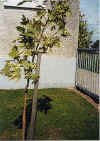Stop 10 on Trail2 Mature Maple Leaves and fruit
Our maple tree is a variegated maple and was planted in 1997. This tree is very special to us as it was planted in memory of Keith Power, one of our pupils who died after a long illness while still a pupil in our school. We chose a nice quiet, peaceful corner to plant the tree.
There are many species of maple and below we have written about the most popular ones.
Family - Aceraceae
Maple is any of about 120 species of broadleaf trees and shrubs common in forests of the Northern Hemisphere.
Maples are easy to recognize because their leaves grow in pairs on opposite sides of the branch, and each leaf has several lobes. No other North American tree has opposite, lobed leaves. Nearly all maples lose their leaves in the autumn. In numerous species of maples, the leaves turn bright orange, red, or yellow before they drop off.
Maples flower in the spring, either before or at the same time the leaves appear. Most maples bear male and female flowers on the same tree. Maple seeds, sometimes called keys, grow in pairs and have flat, thin wings that make them whirl and float in the wind as they fall. Breezes can carry the seeds far from the parent tree, thus helping maples spread to new areas.
Maples are an important source of lumber. Some species have very hard, strong wood. Manufacturers use it to make furniture and musical instruments. The sap of certain maple species is used to make maple syrup. People also plant maples as shade trees.
Sugar maple is one of the most common trees in the broadleaf forests of southeastern Canada and the northeastern quarter of the United States. Sugar maple wood is the hardest and strongest maple wood. It polishes well and is widely used for furniture, cabinets, and violins and other musical instruments. It is also used for making bowling alleys. People also value the sugar maple for its sweet, flavorful sap.
The red maple has red twigs. In the fall, its leaves usually turn red. People sometimes plant the red maple as a shade tree in yards and along streets because it is colorful in both spring and fall and grows well in most soils. Furniture makers sometimes use the wood of the red maple.
The silver maple was once popular as an ornamental tree because it grows fast. But people seldom plant it today because its branches break off easily in storms and the leaves are not colorful in the fall.
Boxelder was used as a street tree because it grows fast when young. However, they rarely plant it today because its branches split off easily.
Bigleaf maple leaves may measure 6 to 12 inches (15 to 30 centimeters) across. The wood is sometimes used for furniture and musical instruments.
The Norway maple averages
about the same size as the red maple. It is an important timber tree in northern
Europe.
Maples contribute valuable wood products, sustain the maple sugar industry in
countries such as Canada and help to beautify the landscape. Maple wood, which
varies in hardness, toughness and other properties, is in demand for flooring,
furniture, interior woodwork, veneer, and small woodenware. Maple is also highly
prized in furniture building and cabinet-making.
The maple leaf is featured on the flag of Canada.



